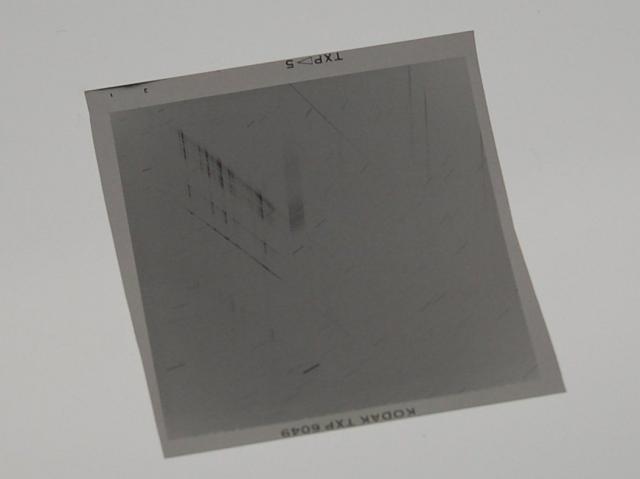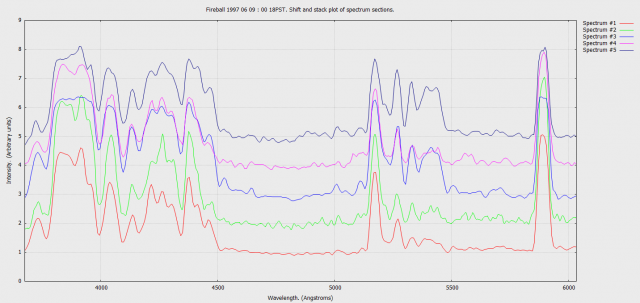- This topic has 8 replies, 4 voices, and was last updated 6 years, 8 months ago by
 Bill Ward.
Bill Ward.
-
AuthorPosts
-
11 March 2019 at 9:36 pm #574282
 Bill WardParticipant
Bill WardParticipantHi,
I was recently contacted by the well known Canadian meteor observer Ed Majden. He had seen my spectroscopic meteor work online and asked if I could help him with a 22 year old puzzle. In 1997 he had caught a fireball on his film medium format system. (The picture has appeared in books and magazines many times since.) He wrote a paper for the Journal of the Royal Astronomical Society of Canada about his use of plastic grating material and this capture which was published in 1998.
Despite there being a beautiful Balmer line spectrum of Vega and even the correct mention of the Na line no viable spectrum has ever been extracted from the image! Ed sent it to several “experts” and was told is was “unmeasurable”. I found this quite surprising (imho it’s not that the “pro’s” couldn’t do it, it’s probably just that they wouldn’t, but that’s another story…). I replied asking “why was it unmeasurable?”. Ed then explained, I quote “They say the dispersion is nonlinear when compared to the Vega spectrum in the same f.o.v.” Now, that I did find genuinely surprising because, all things being equal with the optics, gratings can only ever produce the same dispersion in any given order, the laws of physics!
A shot of the original negative Ed sent to me is below.

“Unmeasurable”, now that’s a challenge I couldn’t resist!!! ;-))
I scanned the negative at a few different resolutions to get the optimum for processing. It took about 4 hours and most of that was trying to get out of a hole I dug for myself after I decided to double check and the double check had the error in it. If any of the “experts” did what I did this may have been the root of the dispersion problem but then to give up so easily…
Anyway, long story short, cracked it. Ed has suggested we co-author a paper reprising the original with the new spectra I’ve managed to produce. As Ed wants to do this initially for the JRASC I don’t want to blow the gaff so I’m not going to show the hi-res spectra or other graphics I’ve produced.
However, here’s a sneak preview of a selection of spectra along some interesting zones.

To produce such a spectrum on film and at f4, this must have been quite some fireball. Unfortunately Ed inform’s me that no visual reports were ever filed.
Cheers,
Bill.
Attachments:
12 March 2019 at 11:11 am #580850 Robin LeadbeaterParticipant
Robin LeadbeaterParticipantHi Bill,
I remember reducing some photographic spectra for Ed Majden some years ago. Not sure what he did with the results though.
You can get variations in dispersion across the field in objective grating spectroscopy due to geometric distortions caused by the lens optics (eg pincushion/barrel etc) though I am guessing this was not the problem here. It is possible to characterise them (though not so easy retrospectively) by moving a check star spectrum around the frame (This technique also useful for characterising flat field effects which are very difficult to correct for otherwise in slitless spectra)
Cheers
Robin
12 March 2019 at 3:31 pm #580852 Bill WardParticipant
Bill WardParticipantHi,
Well, as I said, all things being equal…
You can see the curvature on the image and if it was this small discrepancy then that’s more lazy than I am! As long as there is no point of inflection along the dispersion then the spectrum can be corrected on the fly provided a few bright lines can be identified.
I’ve tried the method that C. Buil described using images of grids for distortion correction but it’s frankly not worth the trouble at your average meteor spectrum resolution.
Cheers,
Bill.
12 March 2019 at 6:06 pm #580854 Denis BuczynskiParticipant
Denis BuczynskiParticipantI remember the late great Harold Ridley used to measure photographs on film of objective prism captured spectra of fireball taken with his own equipment and also those of Henry Soper whose equipment was on The Isle of Man. I think some of these results will have been published in the JBAA. I may be wrong but I seem to remember that Harold was the first person(in the UK?) to record a fireball spectrum on film. He measured the films using plate measurments techiniques.
12 March 2019 at 7:39 pm #580855 Robin LeadbeaterParticipant
Robin LeadbeaterParticipantHi Bill,
Well I had to guess as you have not revealed “where the experts went wrong” 😉
13 March 2019 at 12:05 pm #580858 Bill WardParticipant
Bill WardParticipantHi,
Since I may well have done the same thing, (but realised what was going on and am sticking to that story), I’m keeping it a secret to save their blushes… ;-))
cheers,
Bill.
13 March 2019 at 12:13 pm #580857 Bill WardParticipant
Bill WardParticipantHi,
I was sent Henry Soper’s remaining original material a while back but I’ve never seen any of Harold’s. It’s quite fascinating to see the differences between the film results and current video systems.
cheers,
Bill.
PS, Had to check. Yes, one of Harold’s photographs is in Neil Bones’ book. I knew I had seen one recently. Do you know what happened to his originals?
I have scanned the ones from Henry, ultimately I’ll send them to the BAA for archiving.
15 March 2019 at 6:00 pm #580860 Derek RobsonParticipant
Derek RobsonParticipantHi Bill
It is good to see someone willing to extract spectra from this old film negative. To have captured that spectrum on film 22 years ago was an excellent achievement. I too was surprised at a response of unmeasurable. It looks like a spectrum that can be digitised. I wasn’t aware there could be non linearities but surely that could be compensated for with calibration checks, or, could relative ratios of certain wavelength pairs along the spectrum, be checked to help confirm linearity or not? [of course, one needs to identify the peaks though].
I recall reading an article which included a picture of a spectrum of a meteor imaged by Harold Ridley which said it was believed to be the first in the UK. I can’t remember if the article was in the BAA journal, or the smaller sized booklet that they used to publish and provide as an insert to the journal. I know I have that in my collection of magazines.
You’ve done an excellent job at extracting the spectra. Some differences in composition? I look forward to the findings.
15 March 2019 at 6:40 pm #580861 Bill WardParticipant
Bill WardParticipantHi Derek,
Thanks, Having tried film based spectroscopy for some 15 years I know the difficulties. I never captured a single one!
I was glad to help, it has been an interesting challenge. It always feels good when you finally see it come together and you actually understand what you’re looking at!
Great fun,
Cheers,
Bill.
PS. Will you be attending the BAA weekend in September at Armagh, or perhaps the IMC again, in Germany this year. Looking forward to catching up with you at some point.
-
AuthorPosts
- You must be logged in to reply to this topic.
